PANEL ZERO (2)
By:
February 3, 2018
Being one in a monthly series of deep-cutting, far-drifting discussions on the comicbook artform and its cultural influences, expressive aspirations and unintended consequences.
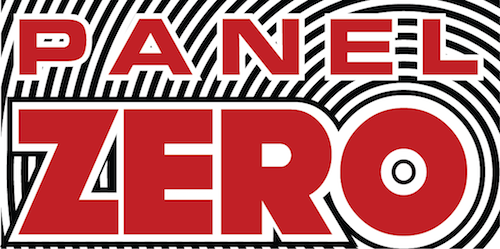
The empire has too many clothes. America likes to think it’s first in all things, but in many cases we’re just alone. The body, like everything else here, is currency; you’re supposed to envy others’ and hide away your own. In much of the rest of the world, all bodies are considered of equal worth, and no one has to worry about it. Even here in the world’s most competitive and covetous country, we’ll one day remember that we all have one, which we’re born into. In the meantime, we can expose ourselves to the unselfconscious beaches and bathhouses, natural spas and public pools and other collective spaces of almost everywhere but here.
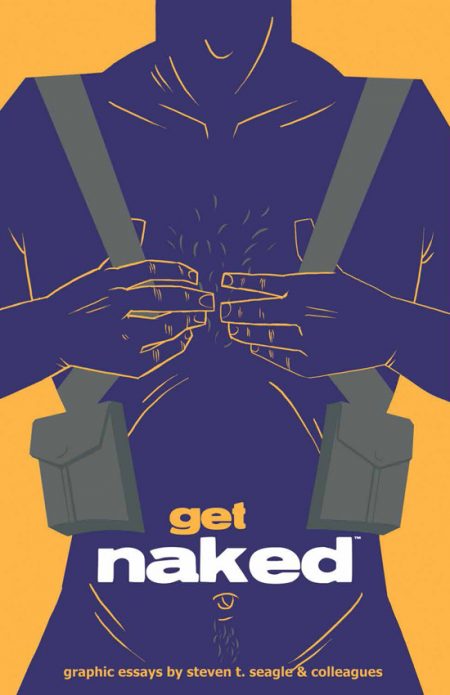
Accomplished animation writer and acclaimed comicbook author Steven T. Seagle (co-creator of Ben 10 and Big Hero 6, for a start) ventured into yet another rewarding discomfort zone to explore the “graphic essay” in Get Naked, a book of memoirs and observations about him facing awkward truths and shedding cultural hesitancies both at home and around the world. It’s a cerebral strain of comicbook lit that plots a course not quite on the same path as any autobio, journalism or nonfiction that’s come before it in this artform, much less the fantasy epics and action-adventures that many associate comics with — yet it’s also vividly physical and immediately felt, conveying the author’s impressions from many unaccustomed locations and unforeseen states of undress.
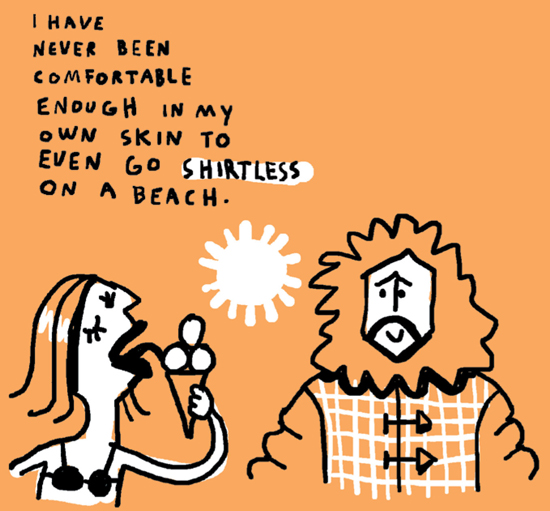
In much the same way that Anthony Bourdain focuses on food as the common denominator to investigate the very different rituals and preferences that distinguish people or bring them together, Seagle sets out from the universal starting point of the lone body to make connections and define where one culture or consciousness ends and another begins.
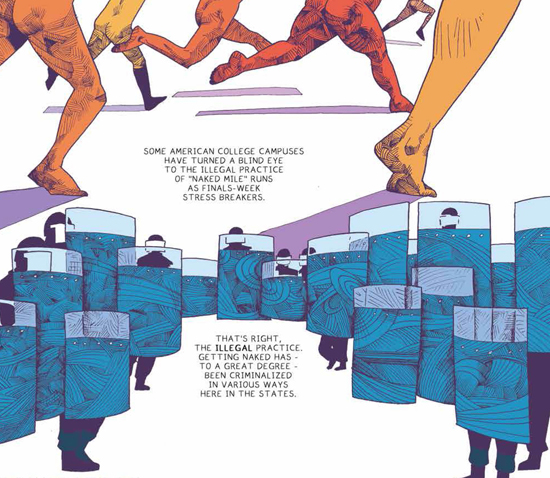
To go there, he trusts in a gifted group of very distinct collaborators, international and visually multilingual though all associated with The Animation Workshop/VIA University College, a cartoon and comics school in Denmark known to him through his world travels, his lecture itinerary and his own well-received works. These creators are all emerging into the art world and wider recognition to tell Seagle’s stories of the borders he’s crossed. Our personalities are best understood when pieced together from both inner and outside perspectives, and the wardrobe of selves that Seagle’s collaborators bring into being are a portrait that does justice to every layer of a life. He gives them a workout that both they and he are superbly fit for, the students’ wide vocabulary in fine-art and vernacular styles complementing and fruitfully clashing with his fluency in multiple storytelling genres and states of consciousness.
We sat down across a continent by video-call to discuss what Seagle’s book looks closely at and brings to light.
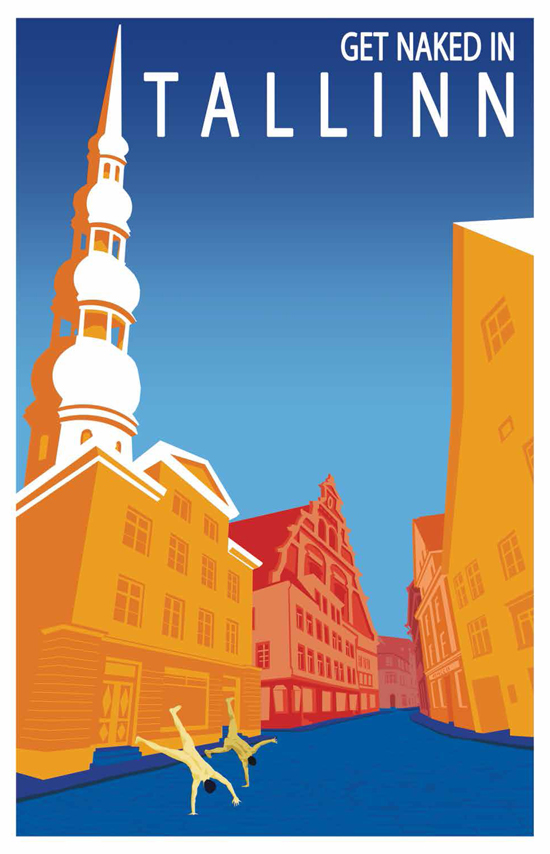
HILOBROW: As big a fan of visual storytelling as I am, I realized that memoir feels natural to me as just text, since it’s like the shed skin of experience; I know I can’t get inside the person’s head fully so I settle for them describing things — but since you did live these stories, what was it like to not only see them visualized outside your head, but by people who had only heard about them?
SEAGLE: Having no ability to draw them myself, in such a way that anybody would want to consume them, I’m kind of subject only to what an outside artist would do for any of my stories. I did thumbnails for a comic once and the artist called me and was like, “What’s the cow on page 1?” And I’m like, “Uh, there’s not a cow, that’s a person” [laughter]; that’s kind of the depth of my ability.
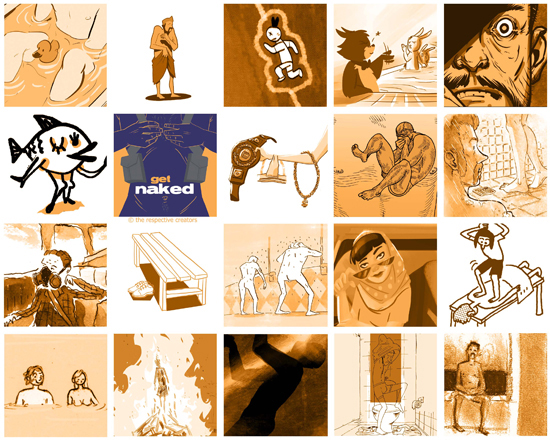
So… I kinda started with the idea that I wanted to do “graphic essays” first, so I wanted to know what that would be like. I spent four years thumbnailing things out and working in Photoshop to try and figure out a pleasing layout or visual dynamic or schema for doing that, and nothing I came up with in the least bit was anything even I would consume as a comics lover. So when I finally had this idea to work with the students over at the animation workshop in Denmark, they were just really gung-ho, and doing all kinds of creative things, so I thought, What if I just tell them good luck, and hand these to them; what would come back? So, it was kind of mindblowing to see the different approaches that they took; the only rule I gave them was I really don’t want big globs of text and an image, like a storybook; and for the most part that was avoided… it was eye-opening for me just in terms of the storytelling mechanisms that they started employing that I hadn’t thought of.
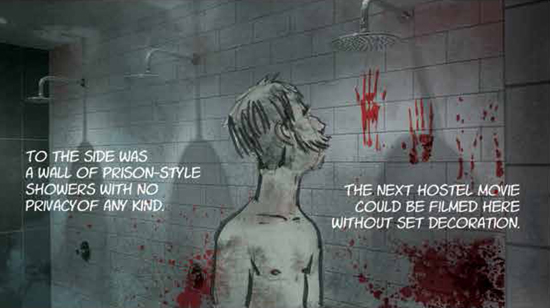
HILOBROW: I was fascinated by the ways that different artists broke down the stories, including a lot of form-follows-function, like the Copenhagen one, how it takes on this modernist, geometric structure to match common associations of Danish design; or how the story and visuals would align by genre-reference, like the one about the bleak Czech spa where you start with the trope of a horror movie and the artist delivers that in kind.
SEAGLE: Yeah, I talked to them a lot about [that] idea — ’cuz I personally don’t like to read text-heavy comics, I mean I read them but they drive me crazy, if there’s just too many words; I’m one of those guys… yet I tend to write comics with too many words. So I asked them to limit the length to 10 pages, to force there to be too many words on a page, and yet then creatively solve making that still visually pleasing. And I was really impressed like, the Copenhagen story for example, just the presence of the circular forms in a way that it made the too-much-text draw your eye around the page; it still felt like comics to me, but then it still feels like an essay — so I thought there was just a lot of really great, inventive stuff that they did to solve the problem of too much text.
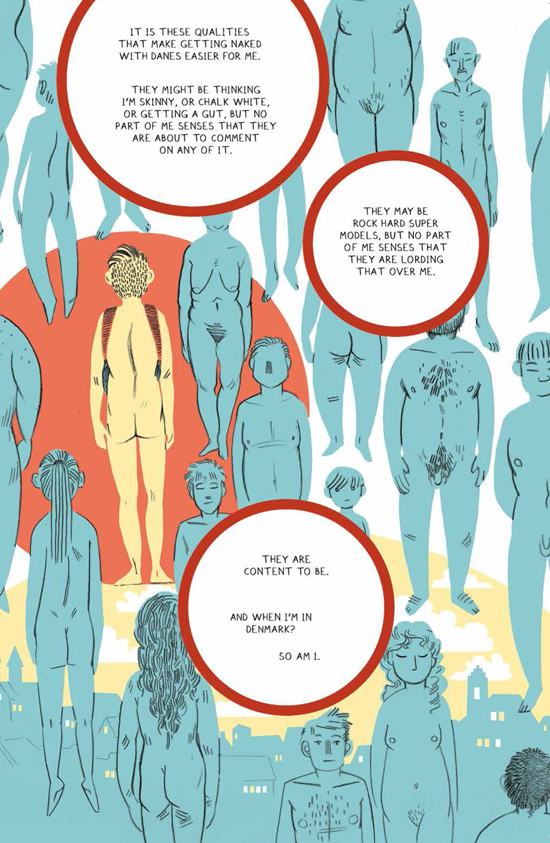
HILOBROW: The book is almost like a telepathic PowerPoint, with the ideas and associative images blurring together…
SEAGLE: I also appreciated that a lot of people did things like, using the text to be a form, or warping the text around images; I thought that created visual life in what could otherwise just be a mind-map. Which is what I think the essays [themselves] are, and I think visualizing a story is always fun in its own way. For this case I felt there was something good about concretizing a lot of these experiences — and the nudity itself, what you visualize versus what they draw, I think it’s better to have a concrete image for a lot of these stories, as opposed to what you might imagine. [laughs]
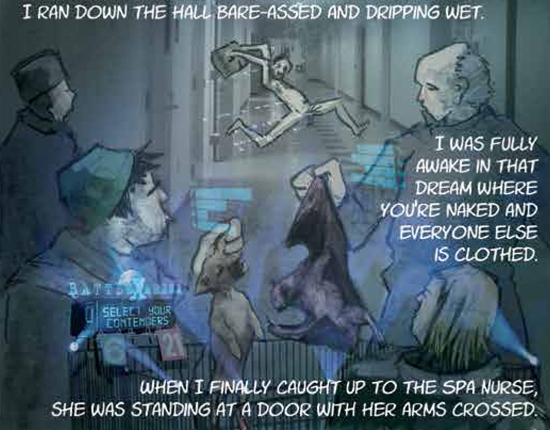
HILOBROW: I did love how in some stories the words themselves become characters, take on the shapes of what they describe, etc. — so in the scripts you didn’t even give directions like that, for the text itself to take that kind of form?
SEAGLE: I’m always trying to change my work method up, and I spent a lot of years writing directions for artists on what I’d like them to draw, so for the essays I just thought, Well this is the essay, but I want you to draw what you want to draw, and the way that you want to tell it.
HILOBROW: It makes it even more interesting, how just a few of them chose to pictorialize the words.
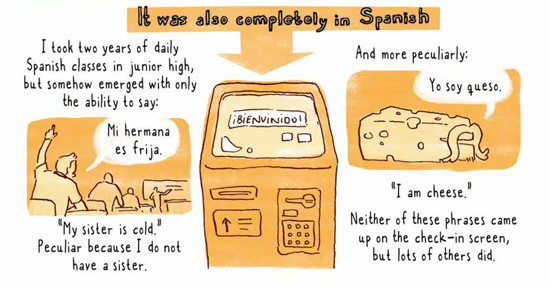
SEAGLE: Also, they’re young cartoonists, and they’re international, so I appreciated the fact that they haven’t looked at a lot of stuff yet, in their careers, so I was thinking, “They’ll either come at this from angles that reinvent things people have done since the dawn of comics, or are completely new takes on ways to get there,” and I think I got a mix of both, which was fun.
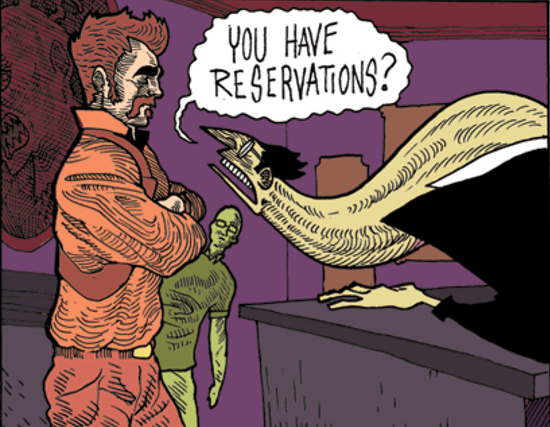
HILOBROW: I’m sure there was some contrast between the pictures you had seen in your head and the treatments once you saw those, but were you aiming to, in some ways, write the separate stories in different stylistic or thematic “languages” for the artists to pick up on? The Sydney story makes me think of the kind of slow-boil paranoia in a Hunter S. Thompson account, whereas others are more idyllic or starkly real; did you want to go for a variety of colors in the very way the stories were told before they even got to the visualizers?
SEAGLE: A lot of these are stories that I tell just verbally all the time, and they’ve taken on lives of their own over the years; and some of them were brand-new things that I wanted to think about and write about, just to pull the theme through the book. I had about four or five that I had done drafts on, ’cuz over the years I’d asked various artists, “If I could crack graphic essays, would you draw one?” So I had written some as samples to show people when I finally got the cojones to think I could do it, and I just never got the cojones — and when I did, because I was going over there [to Denmark], I was like, “Oh, crap, I’ve gotta write all of these!” So I gave myself about 40, 50 days and just wrote, and wrote and wrote and wrote until I had enough for each person that was interested in illustrating one.
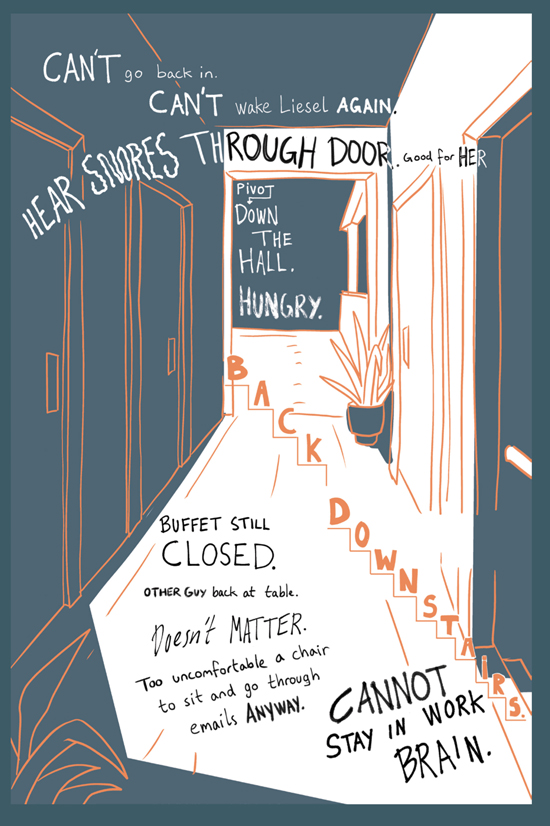
And I really didn’t know how to write essays, it turned out, so I was doing a lot of reading of essays, and tons of rewriting, and just in jumping back and forth I didn’t want them to feel the same. Knowing the different cartoonists, I wanted to have a palette available for them, narratively. And even then they took departures that I didn’t expect. Like, the Baltic Sea essay having no human characters in it at all, it’s all objects and lettering; I didn’t write it with that in mind, but I like it a lot, the way that it got executed. So they had different flavors.
And what we did was, I went over, and we all sat out in a field one day and I read all 19 [essays] out loud to them, and just said, “Everybody don’t tell anybody, but just pick which one you’d like to do.” And of the 19 artists I think 15 were free and clear, only one person picked each essay, and within minutes we were able to juggle out the rest. So I think the feel [of each essay] spoke to the visual vernacular of who was drawing it. And helped them land which one they saw in their head, more than I wrote with some specific visual in mind.
HILOBROW: Like a mystic real-life reenactment of the visual metaphor of dandelion-seeds you use a few times.
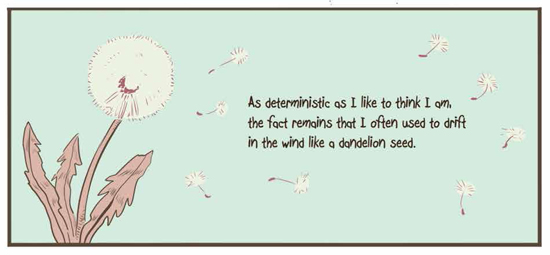
SEAGLE: As I get older, the way I’m staying interested in comics is in trying to get rid of the control parts of my process. I’m getting very interested in chance operation and randomization, which have always been a little part of what I do, but I feel like I know what I’m doing enough [now] that I’m excited when I don’t have control over certain elements of the process that I used to slavishly try to control. I’m just getting into that mindset, and it seems to always work out; I can fret about it, or I can just give over to the universe and it seems to come back fine.
HILOBROW: That makes it more fundamentally collaborative too. Like a dance step that a partner responds to. It’s funny how you mention being surprised by the Baltic Sea story turning out humans-free; that gave me a feeling of a point-of-view camera, like a mundane Blair Witch [laughter] as you just walk around this deserted ship…
SEAGLE: What’s funny about that one is, that is now my memory of that cruise; her images have supplanted what I remember in my head. [laughter]
HILOBROW: You said that many of these stories have been rattling around as an oral tradition for some years — kind of like the Bible, I guess [laughs at own joke] — but did you have a particular sequence in mind, a certain narrative trajectory?
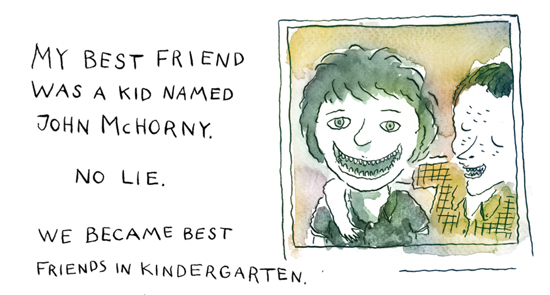
SEAGLE: Speaking of chance operation and randomization, I was kind of panicked about the order, I really had no idea, ’cuz they really were just separate [thoughts], and there’s kind of a geographical organization that’s possible, and there’s a chronological organization, but neither of those two obvious ways to group them created a good flow. Initially, when I was over there visiting, I gave [the artists] 10 days to turn around a draft and everybody did, and then we took several months when I was back in the States to go back and forth and edit and change and clean up and rewrite and whatever, and then suddenly they were done and [publisher] Image was like, “Oh, we’re gonna advance-solicit this book!”
So I had a month less to put it together than I thought. So I literally was just sitting in my office at my house, and I just put ’em out on the floor and laid them out in the first order [that came up], and they were in the same order they’re in in the book. Didn’t really think about it, I just put ’em down one at a time, and just said “That’s it.” And I’m kind of happy with it; it’s like a fusion…chrono-geo…organizational pattern. [laughter] Also, for essays, theme is a lot more important than plot, so I gave over to a thematic progression more than a plot progression.
HILOBROW: To me, there was a very nice feeling of summation with Copenhagen being the last story, where the geometric structure of the pages accentuates, by contrast, the variety and individuality of the bodies we start to see as a backdrop, which then carries over to the Epilogue and its gallery of human types and theme of retraining our senses to see each other the way we really are.
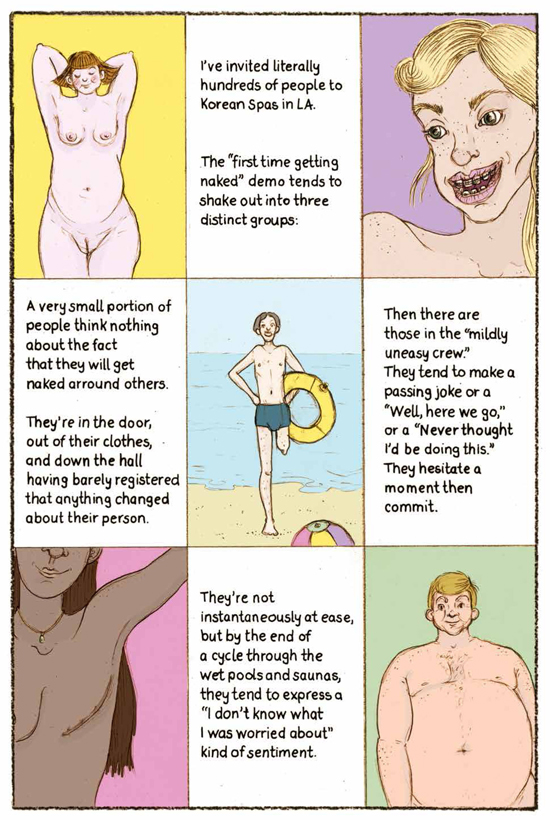
SEAGLE: That’s really the journey that I was on, I’m not a naked person, it’s just never been my mode — now I feel like I am, but not in the “I’ve gotta take my clothes off everywhere I go, including Burger King!” way. [laughter]
HILOBROW: You also frame the book with a quote from Kierkegaard about revealing oneself in writing being a more profound kind of nakedness and honesty; did you only wrestle with the mechanics of what a graphic essay might be, or did you take a while to settle on nakedness as the central metaphor?
SEAGLE: I knew I wanted to do graphic essays, I didn’t know what the subject matter would be initially. So some of the stories I had written didn’t make the book because they didn’t fit the theme I eventually settled on. I just thought, If you’re gonna take a swing at graphic essays, it’s gonna be a hard, hard, hard sell in this marketplace. So then I thought, I need a title that’s at least gonna make somebody give it a chance. So two of the four that I’d written in advance, I thought, These both kind of have a naked angle to them — if I can get the word “naked” in the title, that would at least be a “put your hands on the book and pick it up and flip through it” [factor] — maybe. So then I just started going through [and asking], what else would I write about?
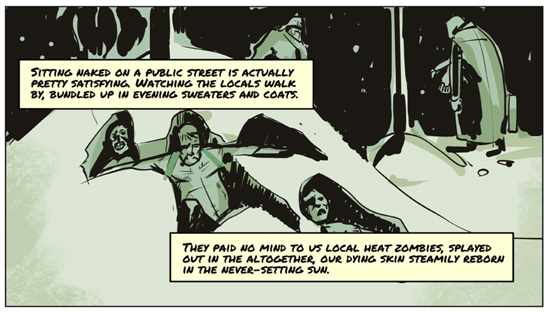
And I do have all these weird travel stories, and they do all seem to have a naked element or a naked throughline, so when I started seeing that, I was like, “can I get to 19 of these things?” And I pretty quickly could. I didn’t really have any trouble telling these stories because, again, I’ve already told them to people, usually over dinner or lunch or a car-ride or whatever. I had a lot more trouble writing It’s a Bird… [Seagle’s classic meta-biography reflecting on Superman fantasies], which is about my family grappling with Huntington’s Disease; that was difficult for me because it was my parents’ guilt and shame that I was trying to chronicle, and the way it impacted me; this [book], because it’s all my own shame or joy or idiocy or whatever’s happening ¬— if you’re a writer, that’s what you’re using anyway.
HILOBROW: The book is very centered on being self-revealing, but it also becomes, in some ways, about everyone but you as the observer, because you’re processing your impressions of so many different cultures (even though you’re always good at reminding us that you can’t claim to be an expert on any of them). Was venturing out into the world as much of an interest as delving into your own feelings?
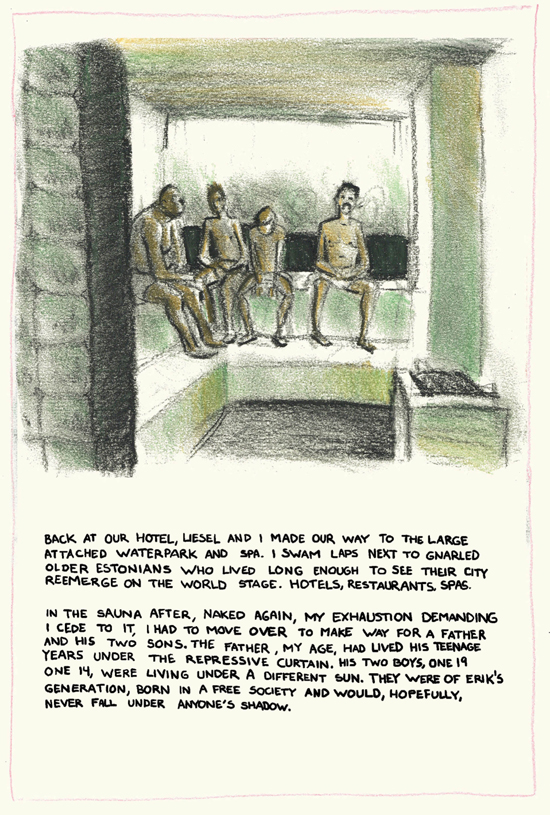
SEAGLE: Just for time purposes, I don’t read a ton of prose, and I’m an extremely slow reader, I read at spoken-word rate ’cuz I used to teach speech. But I love travel stories, I like Paul Theroux’s novels about different places, and the Doctorows I liked were historical or geographical shifts. And I just love travel writing, I like travel shows, I’ve been fortunate enough to get to travel a bunch through comics conventions, or just my own predilections to go places, and I admire the people who tell a good travel yarn. So it was my fleeting attempt to do a little bit of that. And I do think that, the world being what it is, and never ceasing to amaze at how intolerant we can be about any number of things, I think telling stories about cultural difference, cultural similarity, is probably our best bet for finding any way forward. So this is my very very, very very tiny attempt at that.
Get Naked is available from Image Comics on February 7 (comic shops) and February 14, 2018 (bookstores and online retailers).
Images (top to bottom): Mads Ellegård Skovbakke (cover); Sim Mau; Mads Ellegård Skovbakke; Emei Olivia Burell (travel poster/chapter title-page); all contributors (see link above); Bob Lundgreen Kristiansen; Cecilie “Q” Maintz Thorsen; Bob Lundgreen Kristiansen; Emei Olivia Burell; Thorbjørn Petersen; Angelica Inigo Jørgensen; Ingvild Marie Methi; Thomas Vium; Patricia Amalie Eckerle; Aske Schmidt Rose; Silja Lin
Panel Zero logo designed by Steve Price
MORE COMICS-RELATED SERIES: Douglas Wolk’s LIMERICKANIA | KIRB YOUR ENTHUSIASM — 25 writers on 25 Jack Kirby panels | ANNOTATED GIF — Kerry Callen brings comic book covers to life | COMICALLY VINTAGE — that’s-what-she-said vintage comic panels | DC — THE NEW 52 — an 11-year-old reviews DC’s new lineup | SECRET PANEL — Silver Age comics’ double entendres | SKRULLICISM — they lurk among us | Douglas Wolk’s THAT’S GREAT MARVEL, TAKING LIBERTIES, STERANKOISMS, MARVEL vs. MUSEUM, LIMERICKANIA, WTC WTF
MORE POSTS by ADAM McGOVERN: OFF-TOPIC (2019–2025 monthly) | textshow (2018 quarterly) | PANEL ZERO (comics-related Q&As, 2018 monthly) | THIS: (2016–2017 weekly) | PEOPLE YOU MEET IN HELL, a 5-part series about characters in McGovern’s and Paolo Leandri’s comic Nightworld | Two IDORU JONES comics by McGovern and Paolo Leandri | BOWIEOLOGY: Celebrating 50 years of Bowie | ODD ABSURDUM: How Felix invented the 21st century self | CROM YOUR ENTHUSIASM: C.L. Moore’s JIREL OF JOIRY stories | KERN YOUR ENTHUSIASM: Data 70 | HERC YOUR ENTHUSIASM: “Freedom” | KIRK YOUR ENTHUSIASM: Captain Camelot | KIRB YOUR ENTHUSIASM: Full Fathom Five | A 5-part series on Jack Kirby’s Fourth World mythos | Reviews of Annie Nocenti’s comics Katana, Catwoman, Klarion, and Green Arrow | The curated series FANCHILD | To see all of Adam’s posts, including HiLo Hero items on Lilli Carré, Judy Garland, Wally Wood, and others: CLICK HERE
